Affiliate disclosure: This post may contain affiliate links. Please see our Privacy Policy.
Growing cranberries in your backyard is one of the easiest ways to put homegrown food on the holiday table. Cranberries are perennial, and once planted they’ll keep producing crops year after year even with minimal care. Our small 8×8 cranberry bed produces enough to keep our family supplied all winter long, and all it takes is occasional weeding and sand mulch once per year.
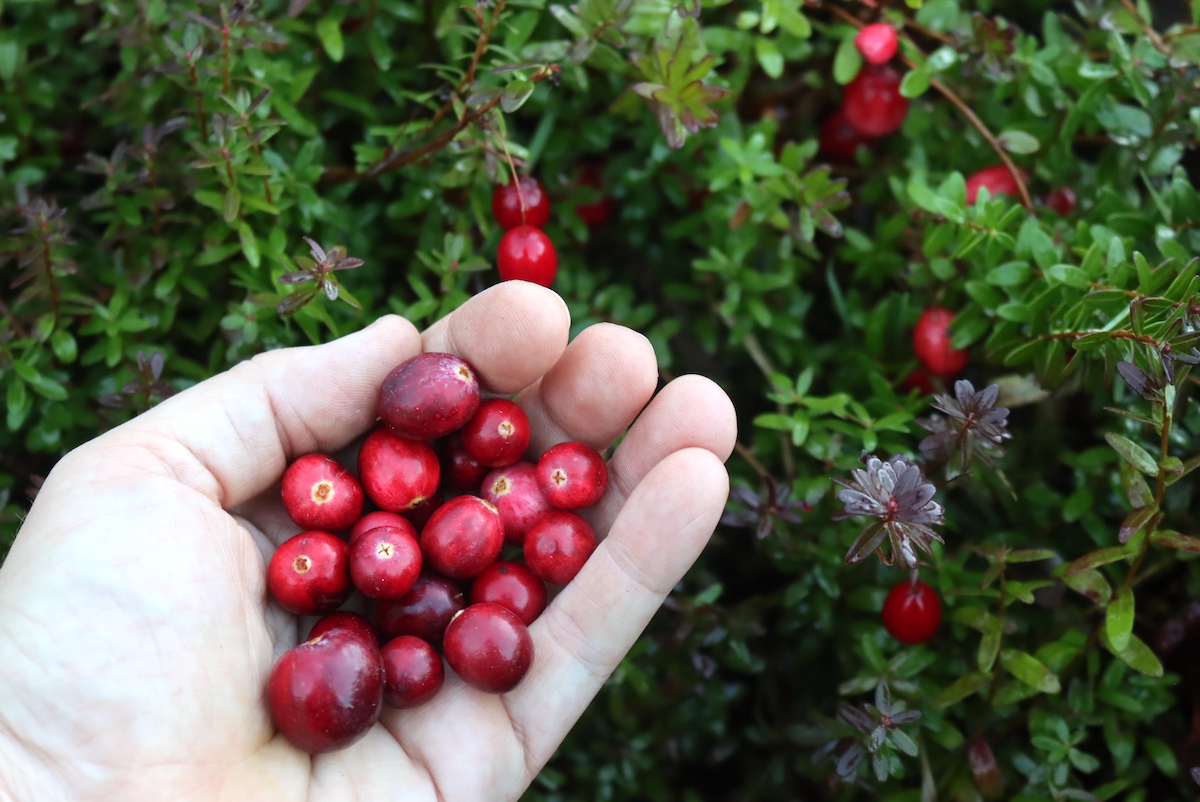
I always assumed cranberries were difficult to grow. Don’t they grow in a swamp?
Don’t you need to flood the fields? We’ve all seen those ocean spray commercials with a thick layer of cranberries floating on waist-deep water.
The truth is, growing cranberries isn’t much different than growing other small fruits like blueberries or raspberries. The berries themselves grow on low-growing perennial ground cover.
Left to their own devices, cranberry plants send out runners a bit like strawberry plants, and re-root as they go until they cover large areas of soil. Sure, you can flood a field with waist-deep water to harvest them…or you can just pick them. Simple as that.
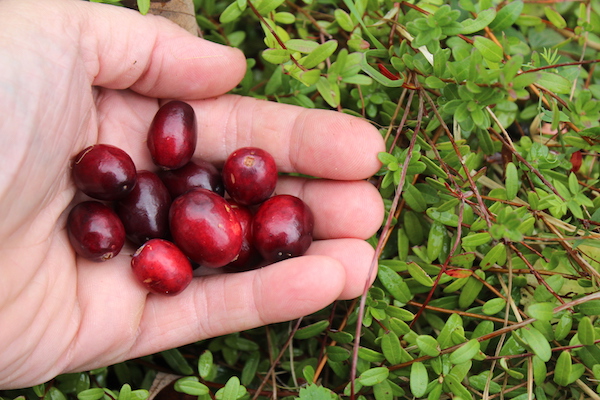
Growing Cranberries from Seed
Cranberry plants grow readily from seed, and a bag of fresh-grown cranberries purchased for the holiday season is all you need to get started. Carefully cut open the fresh fruits and pick the tiny seeds out onto a damp paper towel.
The seeds are very small, about the size of strawberry seeds, and they’re easy to lose. It doesn’t much matter, as a single one-pound bag of cranberries will have hundreds, if not thousands, of seeds.
Fold up the damp paper towel around the seeds and place it in a plastic bag in the refrigerator. Don’t seal the bag, a bit of airflow is good for the seeds. Check on it every week or two so that the paper towel doesn’t dry out, but otherwise, ignore it for the next 3 months.
Cranberry seeds need to cold stratify for around three months to sprout. Our winter lasts a full 5-6 months here in zone 4 Vermont, and our cranberry seeds hunkered down in the fridge that whole time.
(Many different types of seeds also require cold treatment to sprout, and each crop requires a different cold period. For example, when growing apples from seed, they need to cold stratify for 6 weeks.)
Once temperatures warm up, bring the seeds out of the fridge and plant them in a rich peat-based starting mixture. Cranberries like acidic soils, and peat helps to mimic their natural environment.
Keep them warm, around 70 degrees, and the cranberry seeds should sprout in about 3 weeks, but sometimes it can take much longer. Be patient, and keep the soil moist but not soggy.
Once the plants sprout, allow them to grow in pots for their first year. The tiny plants will be fragile, and it’s best to wait until they develop a good root system. Transplant them into a permanent bed in the fall, about a month before the ground freezes over for the winter.
Seed-grown cranberry plants will take 3-4 years before fruiting.
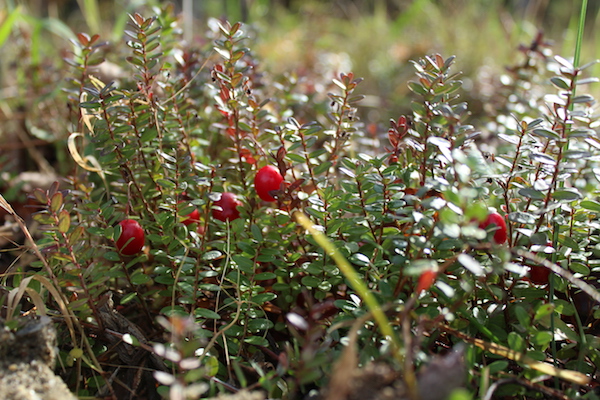
How to Grow Cranberry Plants
While cranberries can be grown from seed, most people start with potted-up nursery cranberry plants. Choose plants that have deep green foliage and ample runners escaping the pot.
We found ours at a local nursery, but they’re readily available online. I actually really love an Ohio-based nursery that sells online through Etsy, and they’ve sent us high-quality plants in the past. They’re where we bought out alpine strawberries, and they also sell other small fruit, like cranberry plants.
Plant cranberries in rich sandy soil, ideally with a bit of peat added. Cranberries generally like moist soils with a high acid content, and peat helps to acidify the soil and hold moisture.
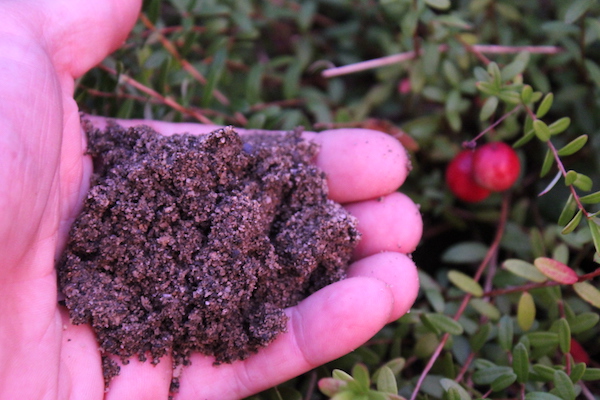
In an ideal situation, plant cranberries in a bed filled with 1 part peat, 1 part compost, and 1 part sand, with clay soil underneath to retain moisture. The extra acidity in the peat helps support mycorrhizal fungus that works with the cranberries to maintain their health, and as an added bonus, the acid suppresses weeds at the same time.
If cranberries are planted in the spring, in a few weeks, you’ll see the first cranberry flowers.
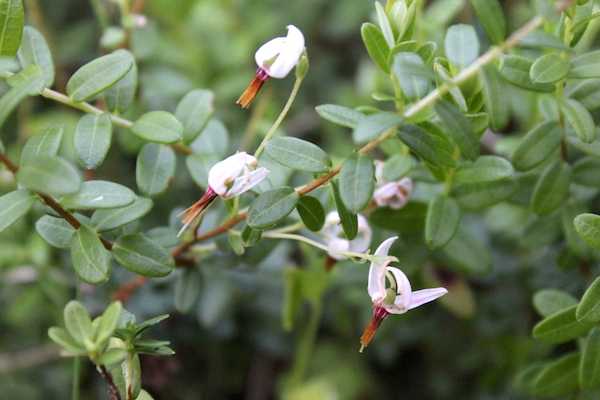
Cranberries are a groundcover plant, but they spread slowly. Grass competition can choke young plants, but once they’re firmly established, they’ll out-compete most weeds.
To help the cranberry plants spread it’s best to mulch them with a covering of sand each fall. The sand mulch helps to bury the side runners and give them a signal to set down new roots.
As cranberry plants set down new roots they’ll colonize new territory and grow in thicker. Eventually, after a few years, they should have completely taken over a bed, assuming they’re initially planted about 18 inches apart.
Here’s one of our cranberry plants fruiting in October here in Vermont. Note the sand mulch all around the plant’s base. Even still, you can see rogue strands of grass growing up through the body of the cranberry plant.
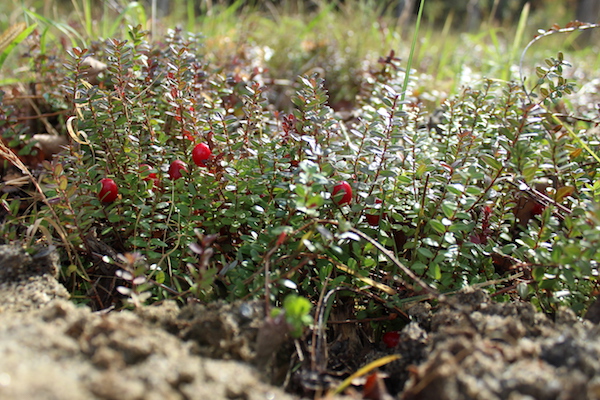
It can be tricky to weed in between the delicate runners without damaging the fruit. That’s why sand mulch is helpful because it suppresses grass and encourages cranberry root formation.
(Growing lingonberries, a closely related plant that’s popular in nordic countries, is quite similar. They’re sweeter, with less acidity, and they’re delicious fresh or in sauce.)
How to Harvest Cranberries
Cranberries do float, and it saves work for large commercial operations to just flood the fields and harvest them all in mass. For the rest of us, they’re easily picked by hand. We harvest our homegrown cranberries in mid-October, just before the first hard frosts here in zone 4.
Cranberries store for extended periods naturally, and they’ll make it just fine in a bag in the fridge until the holiday season. That assumes you handle them gently, and pick them over to remove any broken fruits.
If you’re saving them for a holiday cranberry sauce, that sauce will improve with a little bit of age. I harvest our backyard cranberries and then can cranberry sauce with cinnamon and spices right away to allow it to meld into a tasty preserve before Thanksgiving.
If you forget to pick the cranberries before it snows, fear not. They’ll still be there in the spring. I know it sounds weird, but so long as they stay insulated under the snow, you can harvest cranberries the following spring once the snow melts out.
This handful of cranberries was harvested in early April, just as the snow was melting out. Since I know where they’re growing, I could have harvested cranberries all winter in that spot. That’s just one way our ancestors preserved cranberries in the field before the advent of refrigeration.
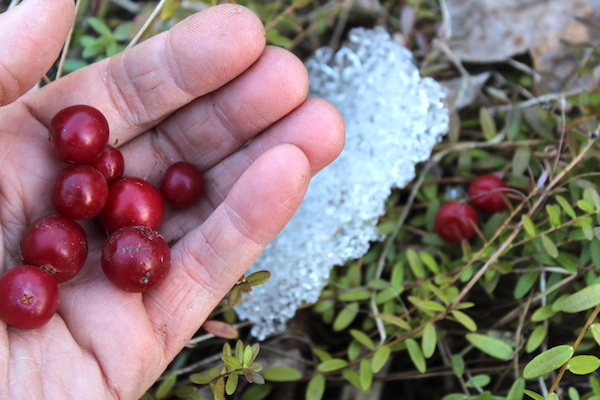
Once the snow melts, however, overwintered cranberries won’t keep. Think of them like a bag of cranberries you’ve pulled out of the freezer.
Once they thaw they need to be kept in the refrigerator and used within a few days so they don’t spoil. If you’re in a rush, they’ll dehydrate nicely, or you can simply keep them frozen by bagging them up and putting them inside the freezer indoors.
Besides preserving cranberries in the field, you can easily make your own dried cranberry raisins using a food dehydrator. Canning homemade cranberry sauce is easy enough, and there’s always homemade cranberry wine…
How are you going to use your homegrown cranberry harvest?
Fruit Growing Guides
Cranberries aren’t the only thing you can grow on your homestead!
- How to Grow Honeyberries
- How to Grow Nanking Cherry
- How to Grow Shipova
- How to Grow Salmonberry
- How to Grow Hardy Kiwi (Hardy to -40 F)
- How to Grow Blackberries
- How to Grow Pineberries
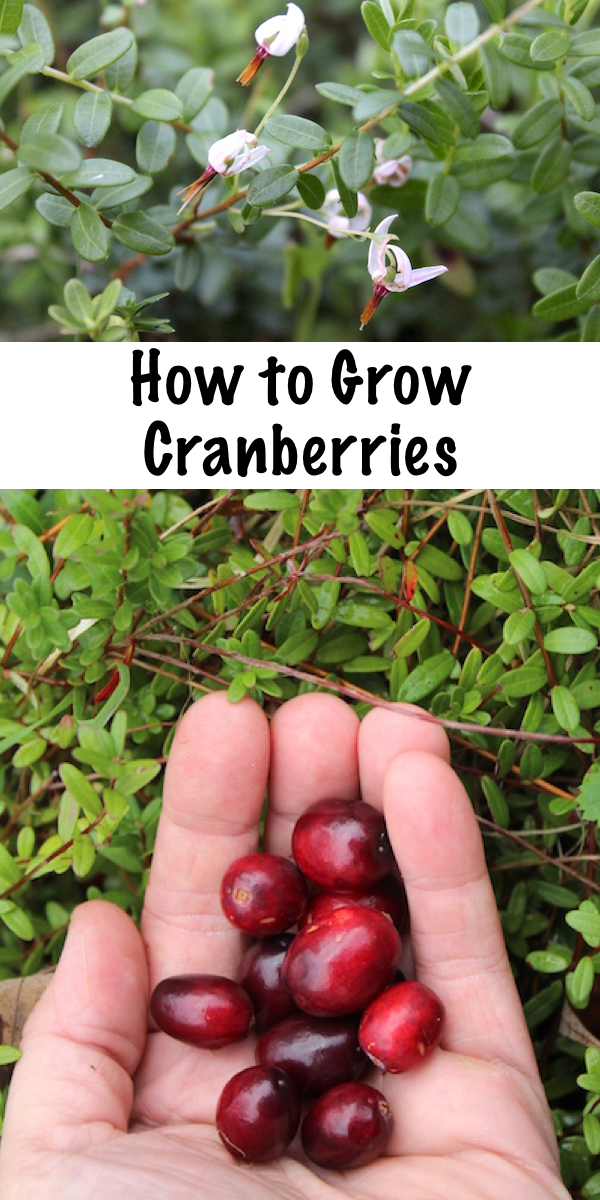




Are you growing highbush or lowbush cranberries? I understand that Highbush cranberries are not real cranberries. Apparently cranberries belong to the blueberry family. What is the variety of cranberry you are growing here? Do they have a name?
Thanks
Melanie
These are lowbush cranberries, and most of our plants are “Steven’s American Cranberry.” You can read more about highbush cranberry here: https://practicalselfreliance.com/highbush-cranberry/
Would cranberries be a good addition to my other berries? Namely Strawberries, blueberries, blackberries and raspberries? I’m wondering if they need their own space or if i could use them as ground cover under the taller berry plants.
Thanks in advance!
Audrey Alexander
Cranberries are really intolerant of competition, and they just can’t take growing with other things in their root zone. They do like the same soil as blueberries, but blueberries also don’t tolerate root zone competition. Both crops are really shallow rooted, and need all the ground to themselves.
Do cranberries need cold to just to germinate or do they need cold each year to fruit?
Cranberries do need cold each year in winter or they won’t produce fruit. That’s the same for apples and many other fruits too. Their requirement is more than many other types of fruit, and they require at least 1500 hours (about 62 days) where the temps are below 45 degrees F. There’s more information on that in this handout from the university of Maine extension: https://extension.umaine.edu/cranberries/wp-content/uploads/sites/40/2020/04/Cranberries-and-a-Changing-Climate-opt.pdf
Hi Ashley, just wondering if Nutritional Yeast is the same thing as the yeast mentioned for making the wine.
Nope, not at all. Nutritional yeast or brewers yeast from the health food section are a different thing. They are a byproduct of brewing, but they’re salted for preservation. They’re not meant to be live yeast for actually making wine. The live yeast you need for that is going to be in a refrigerator, and it’s unlikely to be at a regular grocery store. You’ll need a homebrewing store or online for that.
Hello!! Great information. Very clearly explained.
I bought several bags of fresh cranberrys in Tlaxcala, Mexico in January, I still have one bag in the refrigirator and is still ok. I suppose the time recomended in the refrigirator for the seeds is done considering the months in the fridge. I will procede to extract the seeds from the fruit and plant them in peat moss. Hopefully I will have several plants. The blueberrys are doing great…lots if fruit
Plymouth, MA is a big cranberry producing area (Ocean Spray consortium) and it is zone 6B.
Hello I am in zone 4 here in N.Y. should I be covering my vines they are in a raised bed. Thanks so much Norm
Mine are in a raised bed as well, and they’re quite hardy. They often go into the winter without protection here, and they have no issue (also zone 4). Sometimes when I remember I’ll mulch them in the fall with either sand or peat. This encourages them to re-root again, as parts of the stem are covered. Beyond that, I don’t do anything special for them in a raised bed.
Thanks so much for the information I took care of my beds this morning with pet moss.
You’re very welcome.
Would cranberries plants grow in zone 7B?
I live near Chattanooga.
As far as I can tell, they need more cold than that. Most guides say zones 2 to 6, but zone 6 is marginal and it’s really more like 2 to 5. I think it may be just too warm in zone 7B. (I’m in zone 4 though, so I can’t say from experience.)
When you say that your 8×8 bed yields enough to supply you through the winter, can you give a rough estimate of your harvest? I’m intrigued by giving cranberries a try on a small Scale. I’d be less tempted to put in the work if I’m only going to get the equivalent of one or two store bags, but if there would be enough for several batches of cranberry sauce, it seems really worth it.
Hi Ashley
This is my first year with cranberries. Do I need to do anything to them for the winter?
We don’t do anything for them in terms of protection, they’re very hardy (we’re in zone 4). Mulching them with sand, however, will encourage them to set new roots on their runners and expand the patch. We try (when we remember and have time) to sprinkle about 1/2 inch of sand over the whole patch every fall to help them spread (didn’t happen this year though).
I seriously had no idea I could grow cranberries in Ohio!! We’re zone5 so if you can do it, so can I! Now I’m inspired and need to find some cranberry plants.
Thank you for this post about growing cranberries. Previously, I have picked them on our neighbour’s property (with his permission) but that patch isn’t producing well anymore. I still have some of his in the freezer from a year and a half ago. Do you think those would grow? Having said that, I’m going to look for plants at the nursery in the spring. I’m 71 years old and want to get them growing ASAP. I live in north east New Brunswick so we have similar weather to you.
I planted blueberry plants a few years ago that I dug up. They are producing now I am happy to say.
Since they’re already frozen, I’d leave them there and try pulling the seed out and planting them in the spring. I would think many would still be viable, and since it’s a variety that generally does well in your area all the better. It’s rare to be able to get seed from local cranberries, that’s great!
You also could try, if your neighbor approves, digging out plugs of plants from their patch. Planted in a new, freshly fertilized and prepared bed they might get reinvigorated. That would get you fruit a few years quicker than seeds anyway.
You’ve done it again, Ashley! I was just wondering about cranberries and if I could grow them on our new farmstead. And once again, you were already on it! Thanks for sharing your research and know-how!
Awwww, thanks =)